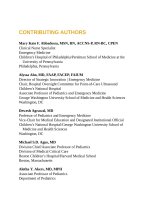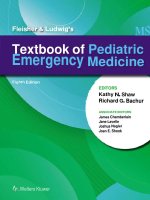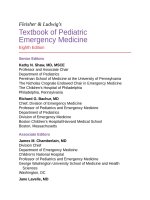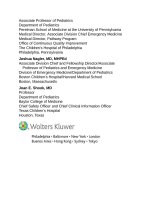Pediatric emergency medicine trisk 0212 0212
Bạn đang xem bản rút gọn của tài liệu. Xem và tải ngay bản đầy đủ của tài liệu tại đây (45.84 KB, 1 trang )
compressions/min), interposed abdominal compression CPR (IAC-CPR), active
compression–decompression CPR (ACD-CPR) using a suction device applied to
the chest, vest CPR, open chest massage, simultaneous ventilation–compression
CPR, and use of automated feedback devices that monitor the quality of CPR. To
date, compression rates and automated performance feedback have been the most
promising. The other techniques are not supported by pediatric data and their use
is not indicated.
Compression rates affect the cardiac output. During CPR, CPP rises during
consecutive chest compressions and falls during pauses. Compression rates of
more than 100 have been shown to improve cardiac output, CPP, and 24-hour
survival when compared with rates less than 80. Although the optimal
compression rate remains unknown, compression rate of at least 100/min is now
recommended for all ages beyond the neonatal period. There is some evidence in
adults that compression-only CPR (no ventilation) produces similar survival rates.
Because of the etiology of pediatric arrest, in addition to a higher metabolic rate
and lower functional residual capacity, this practice is not recommended for
children with an asphyxial arrest.
The optimal duty cycle (compression:relaxation) also remains unknown. To
date, a duty cycle of 50% is believed to provide the highest flow rates. Leaning or
incomplete decompression of the chest during the relaxation phase occurs
commonly and may affect the cardiac output generated by CPR by decreasing
venous return.
Open cardiac massage provides better blood flow to vital organs in animals and
in adults when compared with CPR. However, because of the compliance of the
thoracic structures in children, this technique may not offer any benefit. There is
inadequate data to recommend its use in the resuscitation of children who have
suffered a medical cause of their arrest.
In the newly arrested patient, CPR should be provided immediately to establish
a minimum of circulation to the brain and heart, as this is associated with
improvements in both survival and outcome. Though health care providers may
assume mastery of this seemingly basic skill, many studies have demonstrated
that the quality of CPR administered in both OHCA and IHA meets the AHA
standards <50% of the time. Providers fail to adhere to recommended chest
compression rate and depth; interruptions, overventilation, and leaning are
common. In a case series of out-of-hospital arrests, paramedics provided chest
compressions only half of the available time. In adults, ROSC is associated with a
higher chest compression rate and an increased depth of compression and
decreased pre- and postcompression pauses related to defibrillation. Survivors are









